Science - Manitoba Grade 8 - FULL YEAR BUNDLE
Science - Manitoba Grade 8 - FULL YEAR BUNDLE
Interested in a bundle? Shop below instead!
Couldn't load pickup availability
PRODUCT PREVIEW
PDF AND GOOGLE SLIDE VERSIONS BOTH INCLUDED!
Manitoba Science Curriculum - Grade 8. This product was created to cover all of the expectations in the Manitoba Science Grade 8 curriculum.
There are 570+ activity sheets that cover the elaborations and big ideas in the science curriculum. This massive unit contains readings, surveys, cut and paste activities and a variety of fun activities – drawings, word searches, matching, word scrambles, fill in the blanks, and more!
We have added STEM activities as well as hands on experiments for students to learn the content in the curriculum.
Check out the previews of these units to learn more about how it can benefit your students. We know you will love this no-prep, just print or upload to Google, time-saving resource!
Cells and Systems
Some of the concepts that are covered:
- Characteristics of living things – growth/development, lifespan, metabolism, and cell organization
- What is a cell?
- Cell theory
- Organelles in cells – nucleus, cell membrane, cytoplasm, cell wall, mitochondria and more
- Research assignment – organelle in plant and animal cells
- Diagrams of plant and animal cells
- Comparing plant and animal cells – structure, organelles, size, shape
- Identifying plant and animal cells
- Experiment/activity – building a 3D model of a cell
- Diffusion of molecules in cells
- Osmosis in cells
- Factors affecting diffusion
- Diffusion and the exchange of gas in humans and frogs
- Ideal solutions for cells – osmosis
- Unicellular organisms – Amoeba and Paramecium
- Research assignment – studying unicellular organisms
- Multicellular organisms – humans, worms, and frogs
- Levels of organization – cells, tissues, organs, and organ systems
- Researching organ systems to learn about the organs, tissues, and cells included
- Circulatory system – diagrams, reading and questions
- Circulatory system experiment – testing heart rate and exercise
- Components of blood – red blood cells, white blood cells, platelets, and plasma
- Respiratory system – diagrams, reading, and questions
- Interrelationships between life systems
- Immune system – reading, diagram, and questions
- Vital signs – respiration rate, heart rate, body temperature, and blood pressure
- Immune system – fighting microbes using white blood cells and antibodies
- Medical advances – vaccines and antibiotics
- Microscopes – invention, innovations, and how they advanced cell research
- Electron microscope
- Experiment – examining an onion using a microscope
- Diseases – Stroke, Asthma, Celiac, and Epilepsy – readings and questions for all four
- Stem cell technologies treating disease – Alzheimer's and Spinal injuries
- Researching advantages and disadvantages of stem cells
- Cellular agriculture – cultured meat
- Using cultured meats – multiple perspectives (animals, environmentalists, livestock farmers)
- Unit test
- Answer pages for all activities
Light and Optical Systems
Some of the concepts that are covered:
- What is light?
- Different sources of light – incandescent, phosphorescent, chemiluminescence, bioluminescence
- Properties of light – light absorbing, light reflecting, and light refracting
- Experiment – light maze
- Measuring reflected light using diagrams and a protractor
- Light interacting with different materials – absorbing, reflecting, and refracting
- STEM Assignment – creating a soundproof room
- Experiment – creating a soundproof box
- Light refraction – reading and questions
- Experiment – demonstrating refraction
- Experiment – refraction in water versus saltwater
- Refraction – measuring angles of incidence and angle of refraction
- Optical illusions
- Research - Mirages and Rainbows
- Coherent versus incoherent light
- Vision – how do our eyes work?
- Binocular vision and binocular vision dysfunction (lazy eye, crossed eyes, etc.)
- White light – seeing colours
- Cones and rods
- Additive and subtractive theories of colour
- Technologies using electromagnetic radiation
- Comparing eyes and cameras
- Concave versus convex lenses
- Why we use concave and convex lenses
- Adjusting the magnification by changing the size and position of lenses
- LASIK and cataract surgery
- Optical systems in animals
- Unit test
- Answer pages for all activities
Fluids
Some of the concepts that are covered:
- What is a fluid?
- Understanding viscosity
- Volumetric flow rate
- Factors affecting the flow of fluids – temperature, pressure, density, viscosity
- Flow rate using different sized tubes (different diameters)
- Experiment – comparing viscosities
- Researching the viscosities of various fluids
- Fluids with different viscosities – motor oils (5W-40)
- STEM Assignment – creating a motor oil for Canadians
- Particle theory of matter – fluids
- Relationship between mass, volume, and density
- Density of gases, liquids, and solids
- Calculating density – mass/volume
- Calculating density using diagrams
- How temperature affects the density of fluids
- Comparing a fish’s bladder vs ballast water
- Buoyancy – positive buoyancy, negative buoyancy, and neutral buoyancy
- Experiments determining buoyancy – water vs saltwater vs sugar water
- Experiment – buoyancy of different liquids
- Archimedes’ Principle
- Pascal’s Law – buoyancy
- Performing calculations using Pascal’s Law
- Lighter-than-air flying devices – airships and hot air balloons (buoyancy of gases)
- Air pressure experiments
- Compressing gases – experiment and reading/questions
- Mishandling of compressed gases
- Hydraulic systems vs pneumatic systems
- Assignment – create a hydraulic model
- Researching pneumatic systems
- Pneumatic system – nail gun and air compressor
- Calculating pressure – force per unit of area (Newtons per metre squared, Pascals, Kilopascals, and PSI)
- Regulating fluids in the circulatory system and in engines
- Valves in mechanical systems
- Impacts of fluid technologies – renewable energy (wind turbines, hydro)
- Unit test
- Answer pages for all activities
Water Systems
Some of the concepts that are covered:
- Three states of water in our environment (solid – ice, liquid – water, gas – vapour/humidity)
- Heat capacity of water versus oils
- Water – the universal solvent
- Water characteristics – potable, freshwater, and saltwater
- Saltwater – the total dissolved solids (TDS) in saltwater versus freshwater
- The Cryosphere – glaciers on Earth
- Water distribution on Earth
- Ocean currents and climate
- El Niño
- Global water cycle – diagrams, reading, and questions
- Watersheds
- Lake Winnipeg Watershed
- Research – My Watershed
- Importance of healthy watersheds
- Erosion and weathering changing the Earth
- Weathering, erosion, and deposition
- Meandering streams
- Experiment – flow rate in streams
- Coastal erosion – formation of headlands and bays
- Effects of tides on shorelines
- Controlling coastal erosion – structural barriers, vegetation, and land-use planning
- Factors causing flooding – rainfall, snowmelt, quick thaw, storm surges, dam failures, etc.
- Coastal storms – cyclones, hurricanes, typhoons
- Using dikes and levees to prevent flooding
- Disadvantages of using dikes and levees
- Water table and aquifers
- Groundwater diagrams
- Water quality – pH levels, turbidity, bacteria, dissolved oxygen
- Experiment – determining pH levels in local bodies of water
- Human activities affecting water quality – agriculture, fossil fuels, sewage, pharmaceuticals
- Water treatment plants – research assignment and reading/questions
- Tertiary water treatment systems
- Rural water treatment systems – Septic tanks
- Experiment – creating a water filter
- Rainwater harvesting and greywater systems - technologies
- Desalination systems – converting saltwater to freshwater technologies
- Experiment – desalinization of saltwater
- Climate change – melting glaciers
- Human activities – greenhouse gases
- The effects of melting glaciers
- Unit test
- Answer pages for all activities
This is a comprehensive bundle that will save you hours of planning! It has been tested and found effective in helping students learn the big ideas in the curriculum.
Share
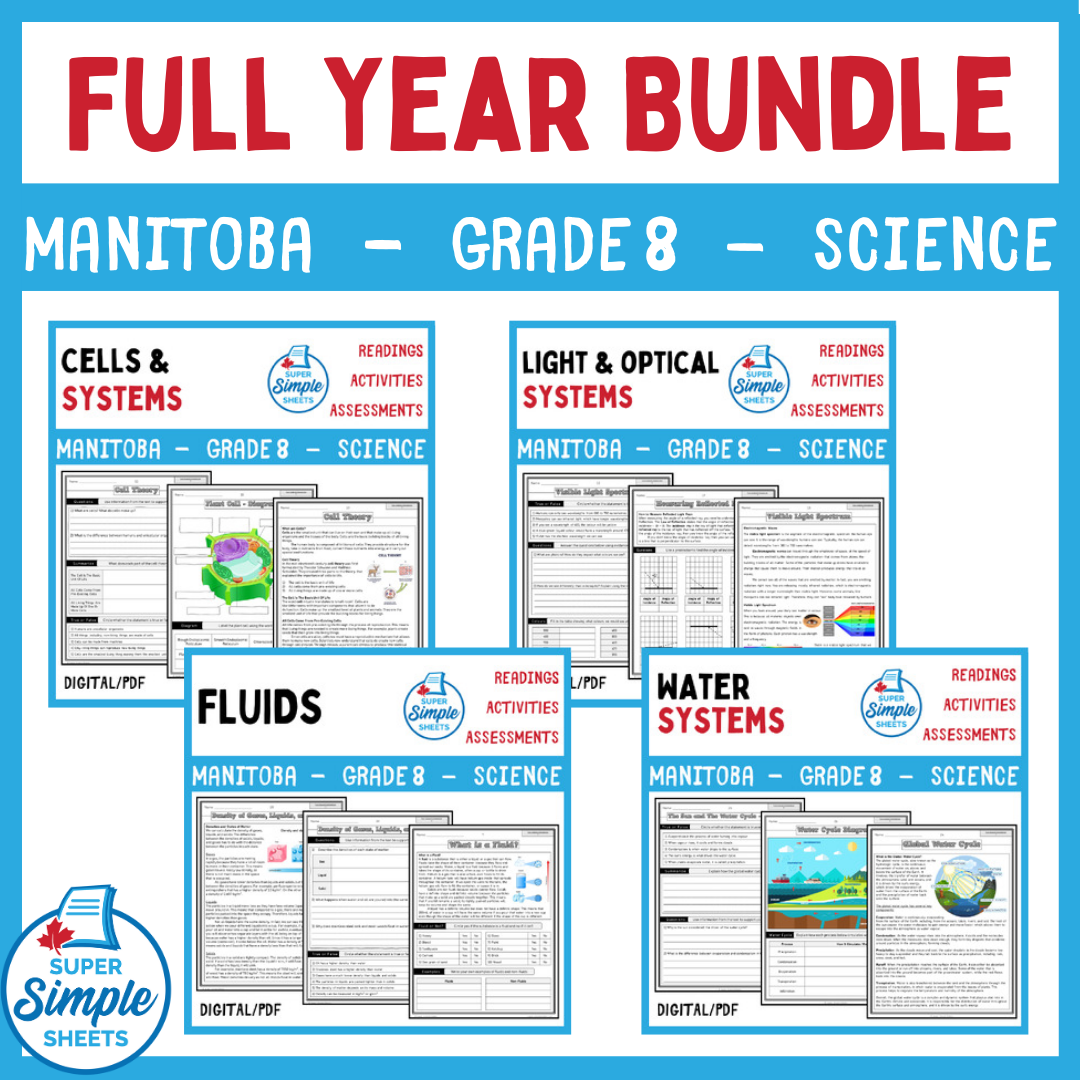
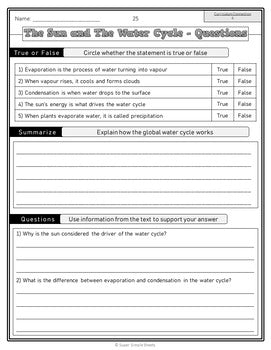
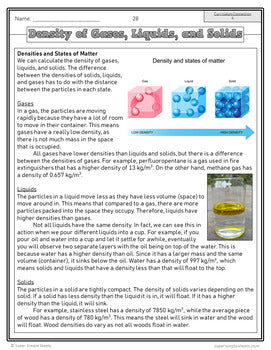
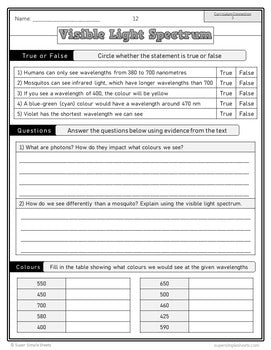
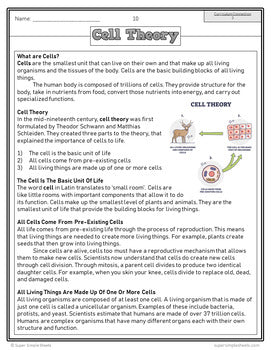
Excellent material for students very easy to follow and lot of exercises
School only starts in MB in September so I haven’t used the Gr. 8 Science bundle yet but I used the Gr. 7 one last year and loved it
! The content was laid out in a great way! It was very easy to make use of! Very helpful for the $!
Extremely happy with the bundle…makes it easier to plan for the new school year…
I’m a student teacher so having this resource is fantastic for a grade level that I’m new too!








